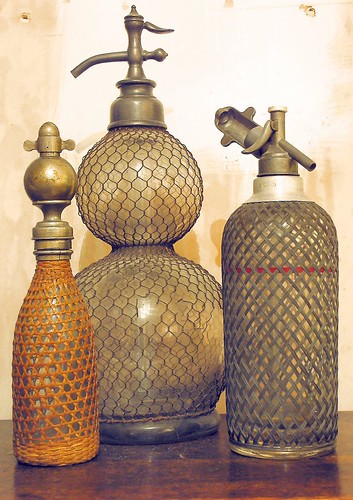Rechargeable soda syphons: (left) 1896 patent Sparklets bottle, (centre) Gasogene circa 1890, (right) Sparklets rechargeable syphon circa 1960.
Sparklets and Gasogenes
 SPARKLETS
SPARKLETS
From "The Sketch" May 11th, 1898. Page 97. (with photo. not reproduced)
"Every Man His Own Lawyer" is the title of a book which a solicitor once told me has been the means of producing litigants. "Every man his own soda-water maker" is the observation that suggests itself by an invention called the "Aerator"; but, in truth, this useful article is not likely not intended, to supersede one's favourite Schweppe. Its value is in circumstances where the ordinary aerated water is not easily obtainable; it has a vast field of usefulness in its applicability to campaigning alone -under conditions where it is only safe to drink your water after it has been boiled. Boiled water is always flat, but with this simple contrivance, simple in its application, you can charge it with carbonic-acid gas, and, by adding a small lozenge, give it a soda, seltzer or potass character. All you have to carry is one bottle, as shown in the accompanying picture, with the carbonic-acid in small steel pellets. Each of these contains sufficient for the one bottle, and the charging is a simple process, easily understood. The bottle is covered with fine wicker, so there should be no danger if it burst in the charging, although this is not expected to be a likely contingency. A company has been formed to work this invention, and the price of your aerated water thus obtained will, it is said, be very moderate."
The British company that is spoken of' in the article was the 'The Continental Sparklets Co. Ltd' of 60 Broad Street Avenue, London, EC.
GASOGENE BOTTLES (American spelling may be Gazogene)
For those who do not know (and why should you) a gasogene is another type of soda syphon. Sir Arthur Conan Doyle's Dr Watson recorded that Sherlock Holmes kept one at his rooms at 221b Baker Street. They were popular from the middle years of the 19th Century.
Photographic examples will be found at
http://www.westminsteronline.org/holmes1951/exhibition/coats.htm
and at
http://www.envf.port.ac.uk/~phillips/Cabinet.htm
an example will be found at along with a sparklets syphon at
http://221bbakerstreetla.com/bs_tantalus.asp



No comments:
Post a Comment